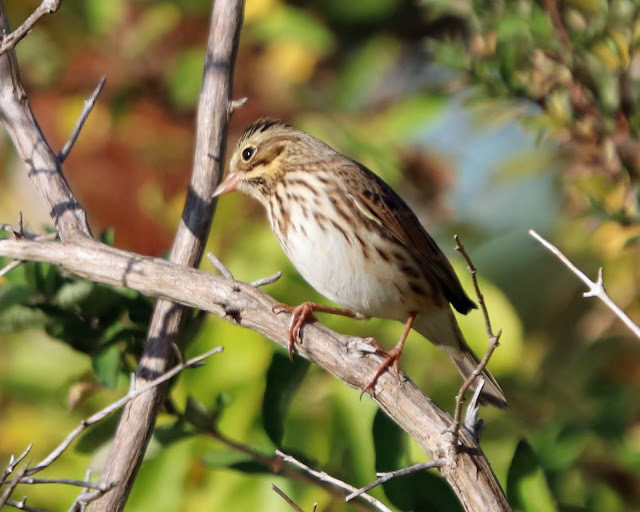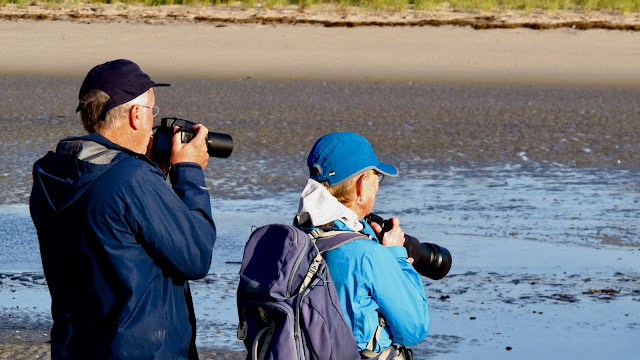 |
| Whimbrel photo by Rich Larsen |
We've visited Parker River National Wildlife Refuge on Plum Island MA many times - and every time we've been fascinated, delighted and enchanted. The mix of ocean, sandy beach, rocks, rivers, salt marsh, trees and shrubs, breeze and sun calms the soul and recharges the spirit.


This time there was a bonus: perfect weather for a full week, including two eighty-degree days ideal for going to the beach.

Spring on Plum Island is all about warblers and other songbirds. Winter is about the owls. In the autumn, it's migrating shorebirds.

When shorebirds find an area of beach or mud flat that's rich in invertebrates to eat, they often stay right there for hours.

 |
| Semipalmated Sandpiper |
 |
| Semipalmated Plover |
("Semipalmated" means that the birds have some webbing between their toes, though not as much as ducks.)
In breeding plumage, the bellies of Dunlins (above and below) are a rich, dense black color. Like many other birds, Dunlins have more subtle coloring after courtship and breeding are done for the year.

If I could fly without carbon,
soar afar with a bird's-eye view;
live off the crustacean rich mud flats and salt pans.
If I could change my appearance to dazzle the females
when the time was right.
AH - the kingdom to join the avian shorebird world.
~ Bernie
 |
| Least Sandpiper |
Many Plum Island beaches are closed each year from May through July (and sometimes into August) to protect the nests of endangered Piping Plovers. By September, most of these little birds have already left the island for points south. We were delighted to see three of them!

+/- 250 Semipalmated Plovers blended into the sand obscuring the Piping Plover who was even more camouflaged, seemingly made of the very sand surrounding it.
 |
| Pectoral Sandpiper |
Every so often, a hungry raptor sent the whole shorebird flock into the air.
They usually circled around a few times, trying to confuse and dazzle the raptor, and then returned to the beach.
A few of the little birds in each flock kept a watchful eye out for another possible attack from the sky.
 |
| Merlin |
 |
| Northern Harrier by Sheri Larsen |
 |
| Peregrine Falcon photo by Sheri |
Shorebirds shared the beaches with several species of gulls. Three of the Great Black-backed Gulls and one Herring Gull were banded so that US Fish and Wildlife personnel can keep track of their travels.


One bird also sported a wing tag:

We'll report the band numbers and might get back information about where and when the gulls were banded.
Birding starts early on Plum Island!

We were with several other people from Vermont and New Hampshire: Mary Ann, Gail, Judy, Jenn, Kathy, Susan, Kit, Larry, Sheri, Marty, and two named Rich. (We also ran into birders from many states and a few distant countries.)






There are scores of Great Egrets and Snowy Egrets.
And even a white torpedo with wings (a mute swan flying by).

Double-crested Cormorants gathered in huge rafts.

And, of course, lots of sparrows ... We saw Song, Savannah and one Saltmarsh.
 |
| Savannah Sparrow by Sheri Larsen |
Northern Mockingbirds and Gray Catbirds sometimes stay on the island year round.

Storms or hurricanes bring surprises. Hurricane Dorian brought several special visitors to the island:
 |
| Whimbrel photo by Sheri Larsen |
 |
| Gull-billed Tern |
The attraction of a "rare bird"
has more to do with
your geography than the bird!
 |
Black Skimmers (9 - 13 oz. with a 43"-45" wing span) dwarfed by the bulky Black-backed gull (46-70 oz., 57"-63" wing span)
|
One thing that Plum Island in the fall DOESN'T have is the dreaded Greenhead Fly! Those things can bite through denim.

Plum Island: miles of sandy beaches, long boardwalks leading to ocean overlooks, pines, plum bushes, dune grass and salt marsh.



 |
| Marsh Loop at Hellcat, still under reconstruction |


 |
| Common Eider - photo by Rich Larsen |
Learning bird IDs is like learning math in school.
If the answer is handed to you, the instant gratification is short lived.
If on the other hand, you search for clues,
observe details, listen to the bird calls -
that bird will become yours for life!
That is a true life bird.










One of the advantages of traveling from Vermont to Plum Island for birding is that nearly all the common birds (for Plum Island) are uncommon for us Vermonters.
And of course watching bird behavior is often full of surprises and brings delight.
One need not
name a bird
to enjoy
its features and behavior.
Beauty is in our appreciation of what we see -
not what we name it.
- Bernie
photos by Bernie, other words by Maeve






Have you ever thought of what the short-legged shorebirds
make of us?
Perhaps they call themselves "peep watchers" -
for people-watching.


Plum Island, like Fantasy Island,
leave your troubles behind.
Seek the experience
you desire.
Celebrate the experiences
that find you!
At sunset
I think
ALL Plovers look like
Golden Plovers.
For more information read the article in The Daily News by Steve Grinley:
Words on Birds: Fall shorebird migration is commencing.
Also, check out Joppa Flats Education Center.
And see our previous visit to Plum Island postings @
https://vtbirdsandwords.blogspot.com/2018/06/plum-island-birds-beach-and-nature.html
and
https://vtbirdsandwords.blogspot.com/2018/06/plum-island-birds-beach-and-nature-part.html
and
https://vtbirdsandwords.blogspot.com/2017/12/plum-island-great-any-time-of-year.html
Emailed comments:
Woot! ~ Bryan
Gorgeous! Makes me want to go birding! - Melissa at Joppa Flats
Will certainly be sharing your photos with the rest of the refuge staff! - Parker River NWR
Complete list of birds seen: Canada Goose, Mute Swan, Blue-winged Teal, Northern Shoveler, Gadwall, American Wigeon, Mallard, American Black Duck, Northern Pintail, Green-winged Teal, White-winged Scoter, Black Scoter, Wild Turkey, Rock Pigeon, Mourning Dove, Black-bellied Plover, American Golden Plover, Semipalmated Plover, Piping Plover, Killdeer, Hudsonian Godwit, Stilt Sandpiper, Sanderling, Dunlin, Least Sandpiper, White-rumped Sandpiper, Pectoral Sandpiper, Semipalmated Sandpiper, Western Sandpiper, Long- and Short-billed Dowitchers, Spotted Sandpiper, Greater and Lesser Yellowlegs, Ring-billed Gull, Herring Gull, Great Black-backed Gull, Gull-billed Tern, Black Skimmer, Northern Gannet, Double-crested Cormorant, Great Blue Heron, Great Egret, Snowy Egret, Turkey Vulture, Osprey, Northern Harrier, Belted Kingfisher, Downy Woodpecker, Northern Flicker, Merlin, Peregrine Falcon, Eastern Phoebe, Eastern Kingbird, Blue Jay, American Crow, Black-capped Chickadee, Horned Lark, Tree Swallow, Barn Swallow, Carolina Wren, European Starling, Gray Catbird, Brown Thrasher, Northern Mockingbird, American Robin, Cedar Waxwing, House Sparrow, American Pipit, American Goldfinch, Saltmarsh Sparrow, Savannah Sparrow, Song Sparrow, Eastern Towhee, Bay-breasted Warbler, Yellow-rumped Warbler, Northern Cardinal
On your next visit to Plum Island, why not stay at our favorite lodging? We love Joyce's airbnb, only steps from the entrance to Parker River National Wildlife Refuge on Plum Island. Aptly named My Plum Island Dream House, this is a beautiful place, spotlessly clean, with two bedrooms, a laundry room, two porches, great shower and beds, and big living/dining/kitchen area.
On your next visit to Plum Island, why not stay at our favorite lodging? We love Joyce's airbnb, only steps from the entrance to Parker River National Wildlife Refuge on Plum Island. Aptly named My Plum Island Dream House, this is a beautiful place, spotlessly clean, with two bedrooms, a laundry room, two porches, great shower and beds, and big living/dining/kitchen area.
For more information read the article in The Daily News by Steve Grinley:
Words on Birds: Fall shorebird migration is commencing.
Also, check out Joppa Flats Education Center.
And see our previous visit to Plum Island postings @
https://vtbirdsandwords.blogspot.com/2018/06/plum-island-birds-beach-and-nature.html
and
https://vtbirdsandwords.blogspot.com/2018/06/plum-island-birds-beach-and-nature-part.html
and
https://vtbirdsandwords.blogspot.com/2017/12/plum-island-great-any-time-of-year.html
Emailed comments:
Woot! ~ Bryan
Gorgeous! Makes me want to go birding! - Melissa at Joppa Flats
Will certainly be sharing your photos with the rest of the refuge staff! - Parker River NWR




























Really enjoyed your fantastic photos and prose. Thanks.
ReplyDeleteFantastic. Love the photos!
ReplyDeleteAwesome! Went for the first time in May, wow!! Will be going back
ReplyDeleteAwesome Pics!!!!!!!!
ReplyDelete